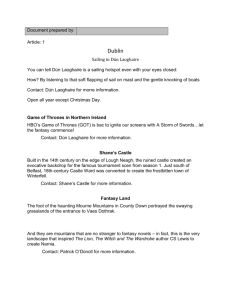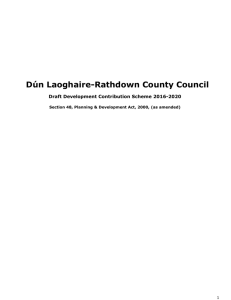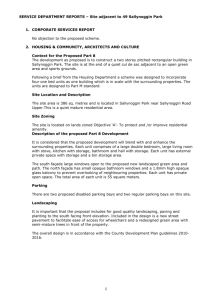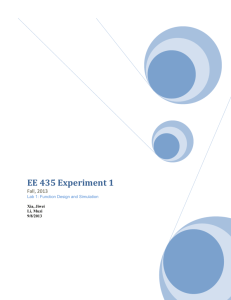8.2 Community Support and Social Inclusion
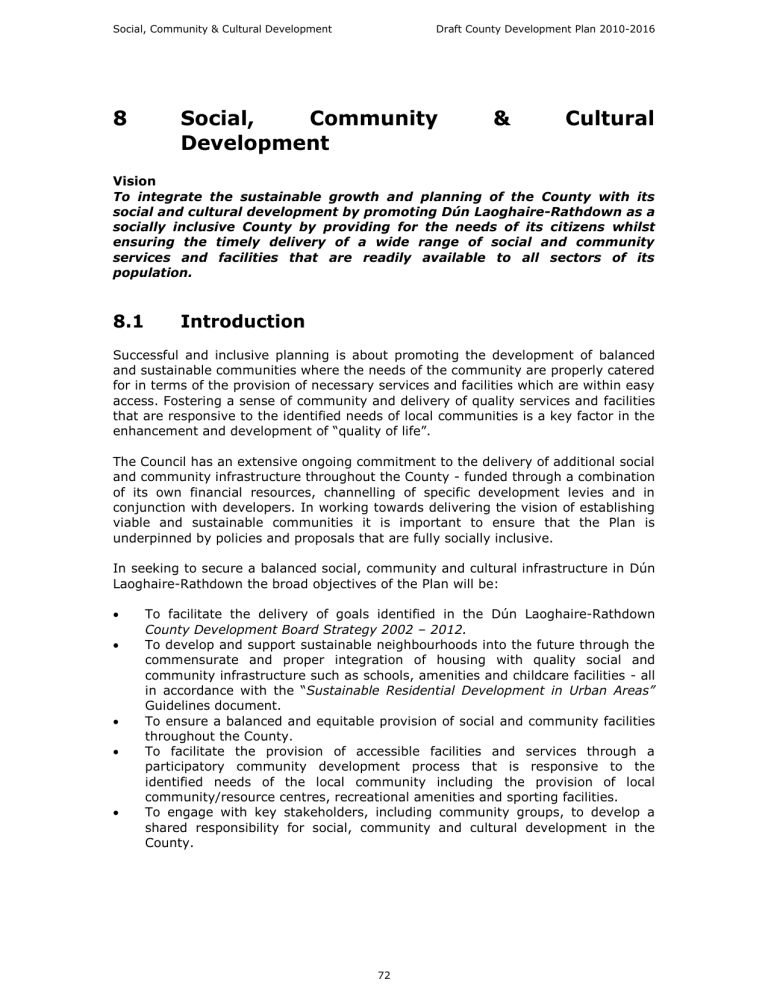
Social, Community & Cultural Development Draft County Development Plan 2010-2016
8 Social, Community
Development
& Cultural
Vision
To integrate the sustainable growth and planning of the County with its social and cultural development by promoting Dún Laoghaire-Rathdown as a socially inclusive County by providing for the needs of its citizens whilst ensuring the timely delivery of a wide range of social and community services and facilities that are readily available to all sectors of its population.
8.1
Introduction
Successful and inclusive planning is about promoting the development of balanced and sustainable communities where the needs of the community are properly catered for in terms of the provision of necessary services and facilities which are within easy access. Fostering a sense of community and delivery of quality services and facilities that are responsive to the identified needs of local communities is a key factor in the enhancement and development of “quality of life”.
The Council has an extensive ongoing commitment to the delivery of additional social and community infrastructure throughout the County - funded through a combination of its own financial resources, channelling of specific development levies and in conjunction with developers. In working towards delivering the vision of establishing viable and sustainable communities it is important to ensure that the Plan is underpinned by policies and proposals that are fully socially inclusive.
In seeking to secure a balanced social, community and cultural infrastructure in Dún
Laoghaire-Rathdown the broad objectives of the Plan will be:
To facilitate the delivery of goals identified in the Dún Laoghaire-Rathdown
County Development Board Strategy 2002 – 2012.
To develop and support sustainable neighbourhoods into the future through the commensurate and proper integration of housing with quality social and community infrastructure such as schools, amenities and childcare facilities - all in accordance with the “Sustainable Residential Development in Urban Areas”
Guidelines document.
To ensure a balanced and equitable provision of social and community facilities throughout the County.
To facilitate the provision of accessible facilities and services through a participatory community development process that is responsive to the identified needs of the local community including the provision of local community/resource centres, recreational amenities and sporting facilities.
To engage with key stakeholders, including community groups, to develop a shared responsibility for social, community and cultural development in the
County.
72
Social, Community & Cultural Development Draft County Development Plan 2010-2016
8.2
Community Support and Social Inclusion
8.2.1
Policy SCC1: County Development Board Strategy
It is Council policy to promote and facilitate the participation of key stakeholders in the delivery of the County Development Board’s,
“Integrated Strategy for Social, Economic and Cultural Development, 2002 –
2012” and in doing so, reach a shared vision for the long-term social, economic and cultural development of Dún Laoghaire-Rathdown.
The Dún Laoghaire-Rathdown County Development Board (CDB) “Integrated
Strategy for Social, Economic and Cultural Development” was adopted in 2002 for the period of 2002-2012. That Strategy was reviewed in 2008 and the priorities for future social, economic and cultural development of the county assessed.
The County Development Plan and the County Development Board Strategy effectively operate parallel to one another with the County Development Board
Strategy providing the social, economic and cultural vision for Dún Laoghaire-
Rathdown whilst the Development Plan provides for the proper planning and sustainable development of the County. It is a symbiotic relationship that delivers a strategic and operational framework to plan and create viable systems for living and working in the County.
By working with agencies tasked to deliver social services in the County, as well as with the community and voluntary sectors and other social partners, the Council will assist in the delivery of the social, economic and cultural development goals of the
County Development Board Strategy.
8.2.2
Policy SSC2: Social Inclusion and Participation
It is Council policy to progressively reduce all forms of social exclusion that can be experienced because of gender, marital status, family status, age, race, religion, disability, sexual orientation and membership of the Traveller
community.
One of the overall goals of the County Development Plan is to promote social inclusion. Social inclusion is defined in many different ways but one of the most common understandings is that through acting inclusively society can ensure that everyone feels able to participate in, and contribute to, community life – no matter their age, ability, nationality, religion or any of the many other characteristics which makes society diverse.
At the local level the Council, through considered policies in relation to housing, community facilities, childcare, public transport, employment opportunities and accessibility will encourage and actively promote an ethos of social inclusion.
8.2.3
Policy SCC3: Safer Living Environment
It is Council policy to facilitate the promotion and delivery of a safe environment for both the residents of, and visitors to, the County.
Ensuring personal safety and promoting an environment of security within the community enhances overall quality of life. It is an objective of the Council to develop secure environments through the promotion of natural surveillance within the public realm, public walkways and open spaces by encouraging supervised
73
Social, Community & Cultural Development Draft County Development Plan 2010-2016 people-centred activities in these areas, supplemented by increased use of targeted lighting and CCTV cameras in liaison with An Garda Síochána. An environment of natural surveillance will also be encouraged in newly planned areas through high quality and sensitive urban design.
The establishment of Joint Policing Committees will enable closer co-operation between communities, policing services and the Council to identify safety and security issues in neighbourhoods and develop appropriate interventions.
8.2.4
Policy SSC4: Estate Management
It is the Council’s policy to support, as resources allow, the continued development of Estate Management structures and programmes in areas identified with a high proportion of Council-owned properties.
The Estate Management programme seeks to enhance the role of neighbourhood development within specific areas. It involves collaboration and participation between residents, the Council and other relevant agencies in the exchange of information and ideas - all with a view to generating a greater sense of involvement and responsibility among residents in the decision-making processes directly impacting on their areas.
8.3
Community Facilities
8.3.1
Policy SCC5: Community Facilities
It is Council policy to support the development and provision of a wide range of community facilities distributed in an equitable manner throughout the County.
The new “Sustainable Residential Development in Urban Area’s” (Guidance document published by the DoEHLG in 2008) stresses the need to integrate housing with the provision of supporting community and social infrastructure. The Guidelines acknowledge that community facilities should be located within, or close to neighbourhood centres and be well served by public transport.
Dún Laoghaire-Rathdown County Council recognises that the facilities that cater for social and community needs are an essential component in designing for sustainable communities. Meeting halls and community centres, along with schools, health centres, doctors surgeries, libraries and churches provide a communal resource through which the residents of a neighbourhood can gain information, education, medical or welfare assistance and social contact. The Council will ensure that an appropriate range of community facilities are provided across the County to ensure that the vitality and sustainability of residential neighbourhoods in Dún Laoghaire–
Rathdown are fostered.
In designing for new facilities it is essential to ensure that they are adaptable over time to meet the changing needs of the population and to provide potential for maximizing their dual usage during evenings/weekends/school holidays.
Where new social and community facilities are being retrofitted into established neighbourhoods the issue of potential adverse impacts on residential amenity and
74
Social, Community & Cultural Development Draft County Development Plan 2010-2016 increased pressures on limited on-street car parking spaces will require to be addressed in a sensitive manner.
In terms of direct provision the Council has an extensive on-going development programme focused on the provision of additional social and community infrastructure. New facilities either recently constructed, or currently in train, include the Samuel Beckett Civic Campus at Ballyogan, the Meadowbrook Leisure Centre and the multi-functional community centres at Cois Cairn, Sallynoggin, Ballyogan, Lambs
Cross, Shanganagh, Meadowlands, Stonebridge Road, Stepaside and Ballaly.
In relation to the provision of other strands of community infrastructure- education, social services and health care facilities - the Council’s role is somewhat more marginal and largely confined to the reservation and securing of sites.
8.3.2
Policy SSC6: New Development Areas
It is Council policy to ensure that proper community infrastructure and complementary neighbourhood facilities are provided concurrently with the development of new residential growth nodes in the County.
The Government’s recent “Developing Areas” initiative seeks to ensure greater coordination and integration of infrastructure and service delivery at strategic growth centres and key development sites. The Initiative emphasises that the roll out of infrastructure should not only match, but should anticipate, development and that improved integration between the provision of housing and essential supporting community and social infrastructure - such as schools, community amenities and child care facilities – should be a pre-requisite.
The planning and implementation of various growth/redevelopment areas in the
County- identified in Chapter 3 – are being advanced through various mechanisms including Local Area Plans, Urban Framework Plans and/or Proposed Strategic
Development Zones (Cherrywood). The detailed assessment of community and social infrastructure needs associated with each of these growth nodes - and the specific programming and phasing of same - will be undertaken as part of these planning processes.
8.3.3
Policy SSC7: Libraries
It is Council policy to promote and develop the County Library Service in accordance with the national objectives laid down in the report “Branching
Out: Future Directions 2008-2012” of the Department of the Environment and Local Government 1998 and the report “Joining Forces : Delivering
Libraries and Information Services in the Information Age” of An
Chomhairle Leabharlanna 1999.
The Council Library Service operates full-time branches located at Blackrock,
Cabinteely, Dalkey, Deansgrange, Dundrum, Dún Laoghaire, Shankill, Sallynoggin, and Stillorgan. There is part time branch in Glencullen.
The implementation of the County’s overall library policy will be in accordance with the objectives and agreed priorities identified in the Dún Laoghaire-Rathdown Library
Development Programme 2004-2010 which seeks to expand the existing branch network to those areas currently without a branch library or to where the need for and improvement of existing facilities and services have been identified.
75
Social, Community & Cultural Development Draft County Development Plan 2010-2016
8.3.4
Policy SSC8: Schools
It is the policy of the Council to ensure the reservation of primary and postprimary school sites in accordance with the requirements of the relevant education authorities.
In the context of increasingly unsustainable commuting patterns by students, the
Guidelines on “Sustainable Residential Development in Urban Areas” (DoEHLG,
January 2008) draws particular attention to the need to plan for future schools provision and advocates timely consultation between the planning authorities and
Department of Education and Science.
A new “Code of Practice on the Provision of Schools and the Planning System”, prepared jointly by the DoEHLG and the Department of Education and Science provides new guidelines for the forecasting of future planning for schools nationally.
The Code of Practice is built around three core objectives:
School provision should be an integral part of the evolution of compact sustainable urban developments where the opportunities to walk or cycle to school are maximized.
The provision of new schools should be driven and emerge from an integrated approach between the planning functions of the planning authorities and the
Department of Education and Science.
Planning authorities will co-operate and co-ordinate with the Department of
Educational and Science in ensuring the timely delivery of schools.
The County Development Plan makes provision for educational facilities through the identification and reservation of potential school sites. The Planning Authority already has well-established lines of communication with the Department of Education and
Science in relation to future school provision and the reservation of sites. Future provision within new growth areas specifically should be planned and implemented in tandem with residential development, especially where the overall scheme is being promoted through the mechanism of Local Area Plans/Strategic Development Zones or similar.
8.3.5
Policy SSC9: Third Level Education Facilities
It is Council policy to support the development and ongoing provision of third level institutions in the County including University College Dublin,
(Belfield and Carysfort campuses); Institute of Art, Design and Technology;
Sion Hill, Blackrock and Dún Laoghaire Senior College.
It is recognized that education is a critical driver of economic success and social progress in modern society. The provision of quality third level education and training is central to the high skills, knowledge and innovation based economy that will underpin ongoing and future prosperity. Improved access to education and training opportunities are also crucial to helping achieve the objectives of a more sustainable and inclusive society.
The importance of third level education to Dún Laoghaire-Rathdown is fully recognised. The primary Third level institutions are University College Dublin and the
Dún Laoghaire Institute of Art and Design and Technology.
76
Social, Community & Cultural Development Draft County Development Plan 2010-2016
University College Dublin (UCD)
University College Dublin occupies a 132-hectare site and is only 4km south of the city centre. The affiliated Michael Smurfit Graduate School of Business, located in
Blackrock is Ireland’s leading business education and research centre.
Current UCD estimates that population growth for Undergraduate Students will bring the population up to 20,176 in 2015. Postgraduate student numbers are expected to grow at a higher rate of 20% which would bring the population up to 8,640 in 2015.
Projected figures for academic staff are estimated at 2,205 for 2015 whilst the number of research staff is expected to grow over the next 5 years with the expected construction of additional research buildings. These buildings include the NIBRT (Bio processing Research and training) Building, IHI (Informatics 2) Building, CRID 2
(Medical Microbiology Research) Building and the MRBS (Health Sciences
Laboratory).
The County Council recognises the significant role that UCD plays in the County and the contribution its education, and research and development activities make to the attractiveness of the County for investment.
The UCD Campus Development Plan 2005-2010-2015 sets out aims and priorities for the future direction of the University. This plan includes a vision for world class architecture, a network of pedestrian walkways and a transformation of the academic infrastructure to reflect the ambitions of a leading European university.
The primary aspiration of the Plan is the advancement and promotion of UCD as a modern university, one that excels in both academic achievement and the built environment. UCD seeks to promote itself as a sustainable, healthy and living campus through the development of both academic and non-academic facilities, increased on-campus residencies and the promotion of knowledge based industrylinked research facilities.
Institute of Art, Design and Technology (IADT)
The Institute of Art, Design and Technology, established in 1997, occupies a 12 hectare site some 3 km from Dún Laoghaire Town Centre.
IADT has seen major expansion in recent years including a new incubation facility, known as the Media Cube, which is specifically focused on the Digital Media sector.
Outline planning permission was also granted in 2008 for the provision of a collection of stand-alone campus buildings including a second Digital Media building, a consolidated workshop and a sports hall.
The National Film School at IADT is a centre of excellence for education and training in film, animation, broadcasting and digital media and a new National Film School building is proposed to be completed by Spring 2010.
The growing academic and administrative needs stem primarily from the growth in student numbers, estimated to increase from 1500 (Year 2003/2004) to 2000-plus full time students and 800 part-time students.
An IADT Master Plan, produced in 2004, seeks to promote the Institute as the leading Irish educator within the knowledge, media and entertainment sectors. It is envisaged that the Plan, aimed at developing a substantial campus infrastructure,
77
Social, Community & Cultural Development Draft County Development Plan 2010-2016 will ensure that the growing needs of the Institute can be met whilst at the same time improving the overall character and sustainability of the campus.
8.3.6
Policy SSC10: Health Care Facilities
It is Council policy to support the Health Service Executive and other statutory and voluntary agencies in the provision of appropriate healthcare facilities including the development of both the system of hospital care and the provision of community-based care primary facilities. It is Council policy to encourage the integration of appropriate healthcare facilities within new and existing communities.
Provision of public health care services for Dún Laoghaire-Rathdown is the responsibility of the Health Service Executive (HSE). At present there are three acute public hospitals in Dún Laoghaire-Rathdown, in addition to the National Rehabilitation
Centre and four privately operated hospitals. There are also ten public health centres and twenty-six nursing homes distributed throughout the County.
The Health Service Executive (HSE) currently seeks to rebalance its approach with a shift from secondary care to primary care provision. The primary care model promoted has a stronger emphasis on working with communities and individuals to improve their health and well-being. Building on the National Health Strategy
“Quality and Fairness- A Health System for You”, the Primary Care “model” aims to ensure everyone has ready access to a broad spectrum of care services through a local Primary Care Team.
The ability of Primary Care Centres to provide local and integrated facilities in line with the Government’s Primary Care Strategy, is acknowledged by the Planning
Authority. Such facilities will be sought on suitably zoned lands and in close proximity to new and existing residential areas to allow communities access to multidisciplinary health care in easily accessible locations throughout out the County.
8.3.7
Policy SSC11: Childcare Facilities
It is Council policy to encourage the provision of childcare facilities as an integral part of proposals for new residential developments. Generally, one childcare facility with places for 20 children shall be provided for each 75 dwellings. The Council will encourage the provision of childcare facilities in a sustainable manner to encourage local economic development and to assist in addressing disadvantage.
There continues to be a growth in demand for childcare services and the provision of good quality and affordable services close to local communities is important. The primary policy basis for the provision of childcare facilities is the “Childcare Facilities
Guidelines for Planning Authorities” (DoEHLG, 2001). In the interest of promoting sustainability the Guidelines advocate that suitable locations for the provision of childcare facilities include residential areas, employments nodes, large educational establishments, major towns/district/neighbourhood centres as well as areas convenient to public transport networks. Dún Laoghaire-Rathdown fully supports the development and delivery of accessible high quality and affordable childcare facilities to address the overall development needs of the County.
The Dún Laoghaire-Rathdown County Childcare Committee, a standing committee of the County Development Board, regularly surveys and analyses the needs for
78
Social, Community & Cultural Development Draft County Development Plan 2010-2016 childcare provision in the County. The Committee is currently reviewing its existing
Strategic Mapping policy to determine the future needs for childcare services and facilities.
Detailed requirements and standards in respect to childcare provision associated with development projects is set out in the Development Management Section of the Plan.
8.3.8
Policy SSC12: Arts and Culture
It is Council policy to facilitate the continued development of arts and cultural facilities throughout Dún Laoghaire-Rathdown in accordance with the County Arts Strategy.
The existing arts and cultural infrastructure of Dún Laoghaire-Rathdown includes theatres, performance spaces, galleries, art centres and outdoor event spaces.
Despite the range of existing facilities, the Council recognizes that there remains a deficit of cultural and arts provision in the County. The Dún Laoghaire-Rathdown Arts
Strategy 2007-2010 recognizes the Council’s pivotal role in the promotion and encouragement of the arts and culture and seeks to redress any obvious deficiencies in the arts generally while prioritising direction for future development and investment. The Council will continue to support and facilitate the Irish language and the aims of the Dún Laoghaire-Rathdown Arts Strategy 2007-2010.
79
